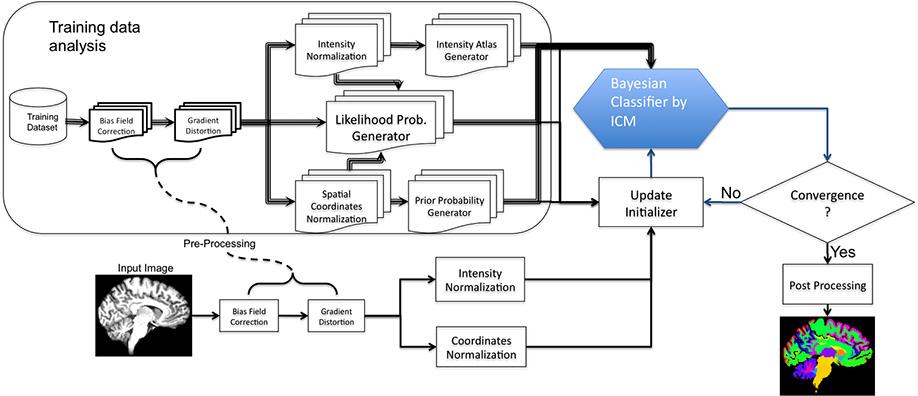
Overview
Conventional Markov random field is hampered by noncausality, and its causal definitions are also not free of difficulties. For instance, the Markov mesh random field has strong diagonal dependency in its local neighboring system. We have introduced multilateral Markov random field (MMRF) to overcome this issue. MMRF is a MRF, whereas the reverse may not hold. The joint distribution of a causal MRF is readily given by the product of the low-dimensional local distribution, whereas in conventional MRF it is only given through Gibbs distribution. Low-dimensional joint pdf’s are often estimated using a joint histogram for homogeneous field or by a few samples of the field for inhomogeneous fields. This makes the model closely tied to the particular image in use. We have used MMRF for the computation of image entropy and mutual information and showed the superiority of their performance in brain image registration.
We have also developed a MAP Bayesian classifier called MMRF-MAP to improve the segmentation accuracy in subcortical structures of the brain. In comparison with Freesurfer subcortical segmentation, our technique showed an improvement in most of the regions. We are currently in the process of extending the model to 3D random field, and are developing the classifier for a 3D model, which we believe will significantly increase the accuracy of the segmentation.
Related Publication
Q. R. Razlighi and N. Kehtarnavaz, “Spatial Mutual Information as Similarity Measure for 3D Brain Image Registration”, IEEE Journal of Translational Engineering in Health and Medicine, vol.2, no., pp.27-34, 2014.
Q. R. Razlighi, N. Kehtarnavaz, and S. Yousefi, “Evaluating Similarity Measures for Brain Image Registration”, Journal of Visual Communication and Image Representation, vol. 24, no. 7, pp. 977-987, 2013.
S. Yousefi, N. Kehtarnavaz, Y. Cao, Q. R. Razlighi, “Bilateral Markov Mesh Random Field and its Application to Image Restoration”, Journal of Visual Communication and Image Representation, vol. 23, no. 7, pp. 1051-1059, 2012.
Q. R. Razlighi, A. Orekhov, A. Laine, and Y. Stern, “Causal MRF for Brain MR Image Segmentation,” Proceedings of IEEE Engineering in Medicine and Biology Society, San Diego, Aug. 2012.
Q. R. Razlighi, N. Kehtarnavaz, and A. Nosratinia, “Computation of image spatial entropy using quadrilateral Markov random field”, IEEE Transaction on Image Processing, vol. 18, no. 12, pp. 2629-39, 2009.
Software Released
Please contact Dr. Razlighi for the Python code and instruction

